Alfa Romeo 8C 2007 Owner handbook (in English)
Manufacturer: ALFA ROMEO, Model Year: 2007, Model line: 8C, Model: Alfa Romeo 8C 2007Pages: 223, PDF Size: 14.35 MB
Page 11 of 223

1
2
3
4
5
6
7
8
9
VEHICLE IDENTIFICATION DATA
ACTIVE AND PASSIVE SAFETY
INSTRUMENTS AND CONTROLS
BEFORE YOU DRIVE
USING THE VEHICLE
IN AN EMERGENCY
CAPACITIES AND TECHNICAL SPECIFICATIONS
MAINTENANCE
TABLE OF CONTENTS
Page 12 of 223
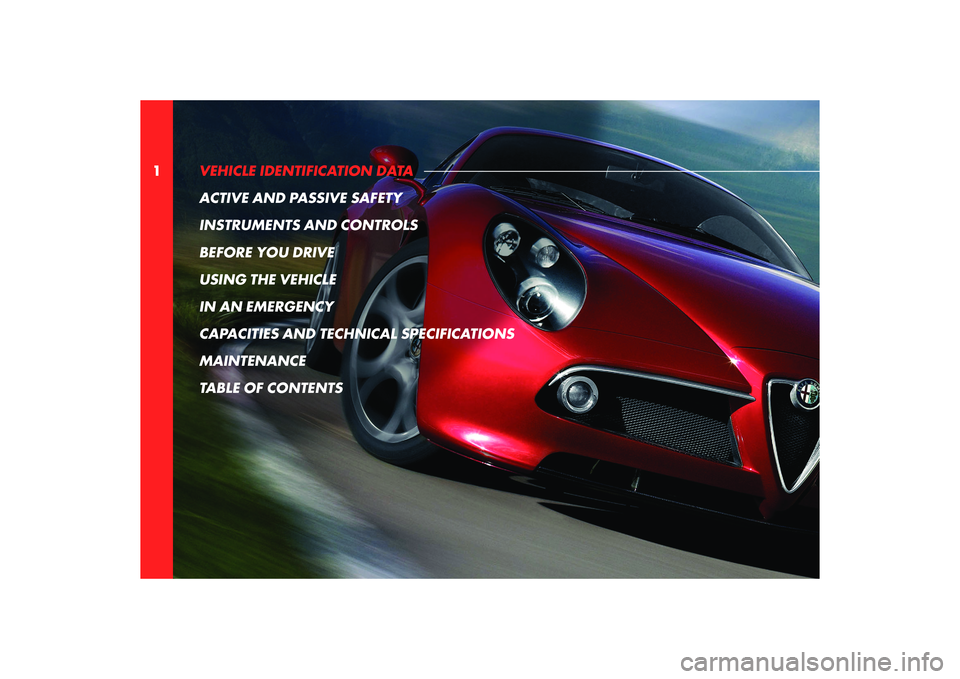
1VEHICLE IDENTIFICATION DATA
ACTIVE AND PASSIVE SAFETY
INSTRUMENTS AND CONTROLS
BEFORE YOU DRIVE
USING THE VEHICLE
IN AN EMERGENCY
CAPACITIES AND TECHNICAL SPECIFICATIONS
MAINTENANCE
TABLE OF CONTENTS
Page 13 of 223
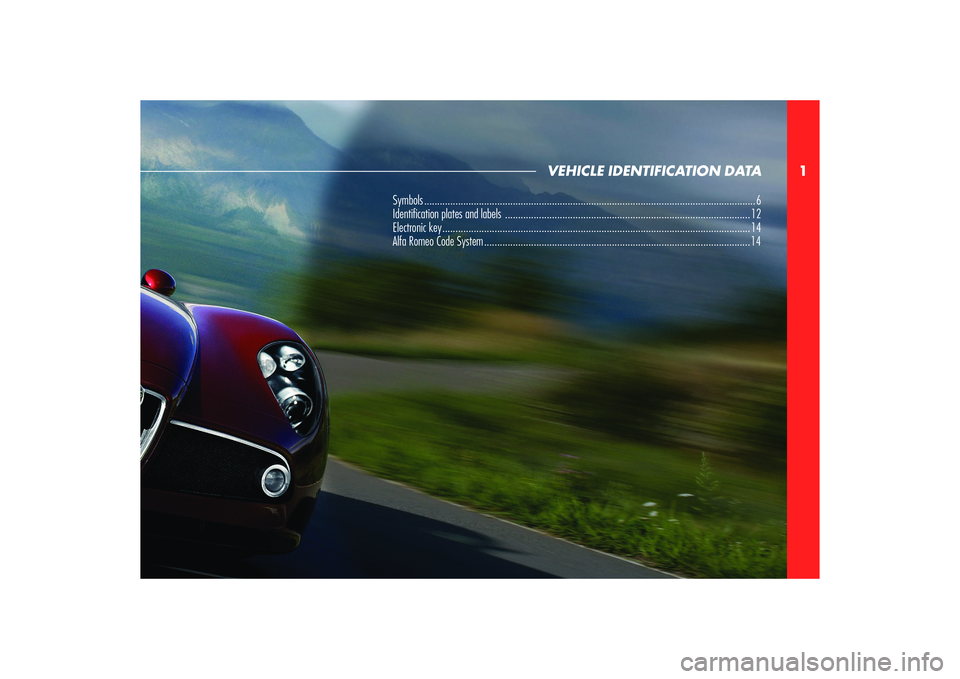
1
Symbols ............................................................................................................................... 6
Identifi cation plates and labels ..............................................................................................12
Electronic key ...................................................................................................................... 14
Alfa Romeo Code System ...................................................................................................... 14
VEHICLE IDENTIFICATION DATA
Page 14 of 223
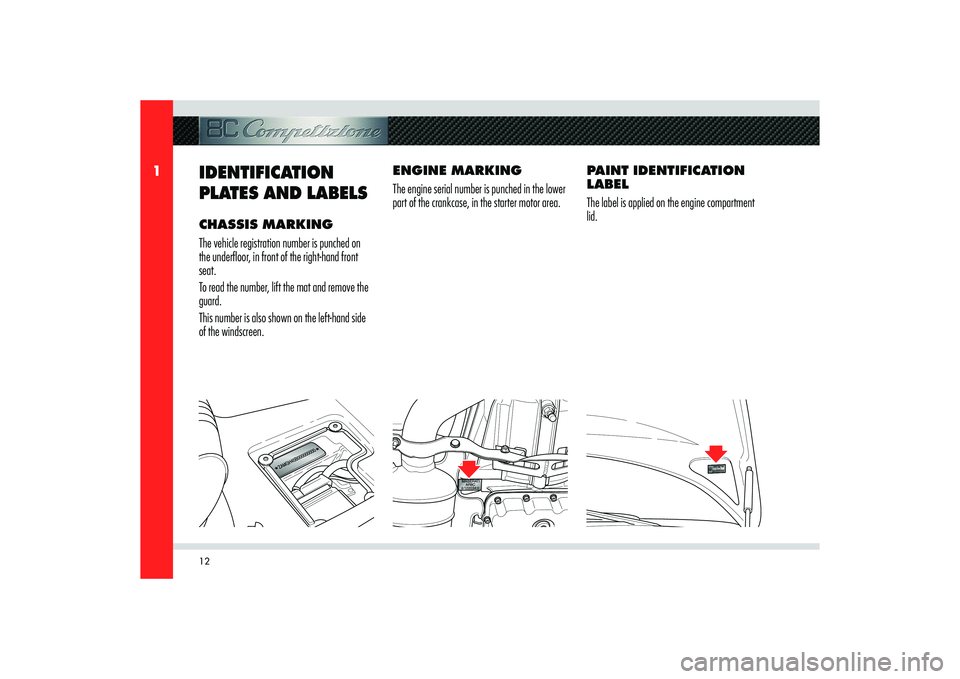
12
1
ENGINE MARKING
The engine serial number is punched in the lower
part of the crankcase, in the starter motor area.
IDENTIFICATION
PLATES AND LABELS CHASSIS MARKING
The vehicle registration number is punched on
the underfl oor, in front of the right-hand front
seat.
To read the number, lift the mat and remove the
guard.
This number is also shown on the left-hand side
of the windscreen.PAINT IDENTIFICATION
LABEL
The label is applied on the engine compartment
lid.
Page 15 of 223
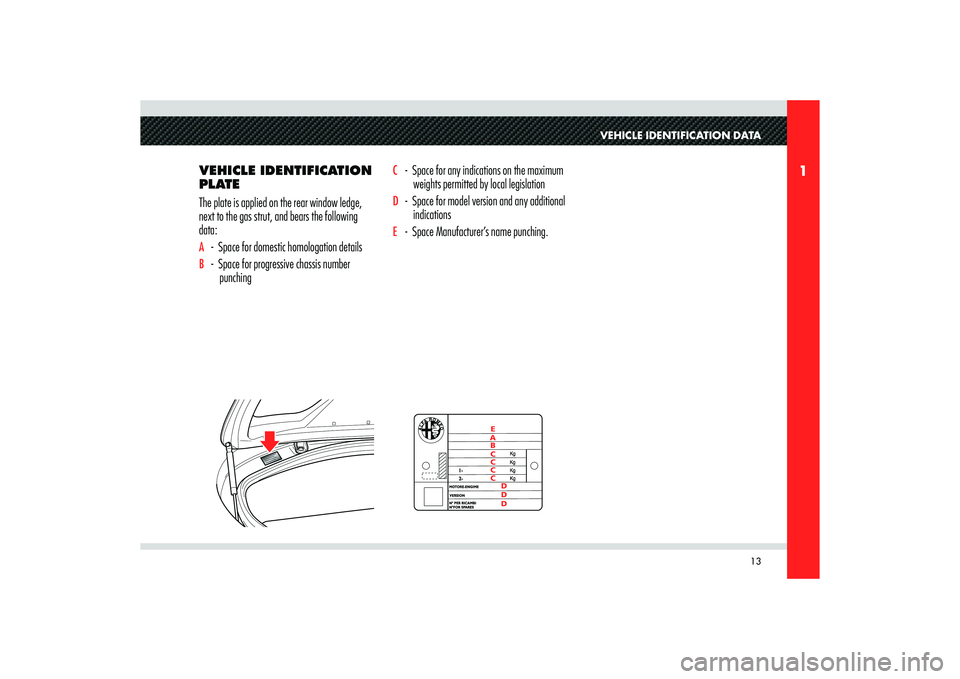
E
A
B
C
C
C
C
D
D
D
13
1
VEHICLE IDENTIFICATION DATA
VEHICLE IDENTIFICATION
PLATE
The plate is applied on the rear window ledge,
next to the gas strut, and bears the following
data:A - Space for domestic homologation detailsB - Space for progressive chassis number
punching
C - Space for any indications on the maximum
weights permitted by local legislation D - Space for model version and any additional
indications E - Space Manufacturer’s name punching.
Page 16 of 223
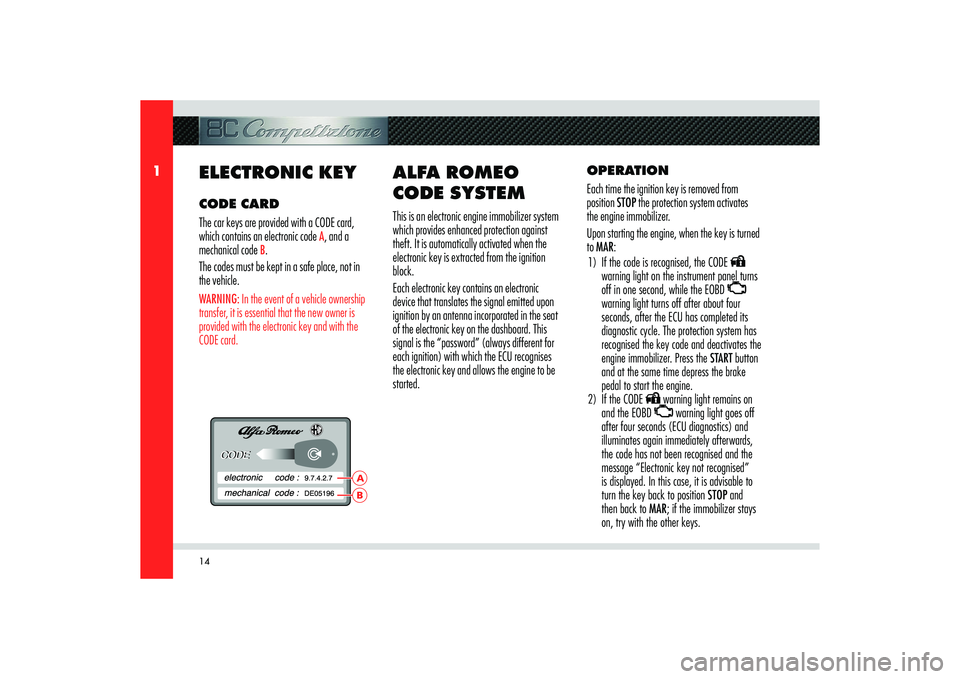
14
1
BA
ELECTRONIC KEYCODE CARD
The car keys are provided with a CODE card,
which contains an electronic code
A, and a
mechanical code
B.
The codes must be kept in a safe place, not in
the vehicle.
WARNING: In the event of a vehicle ownership
transfer, it is essential that the new owner is
provided with the electronic key and with the
CODE card.
ALFA ROMEO
CODE SYSTEMThis is an electronic engine immobilizer system
which provides enhanced protection against
theft. It is automatically activated when the
electronic key is extracted from the ignition
block.
Each electronic key contains an electronic
device that translates the signal emitted upon
ignition by an antenna incorporated in the seat
of the electronic key on the dashboard. This
signal is the “password” (always different for
each ignition) with which the ECU recognises
the electronic key and allows the engine to be
started.OPERATION
Each time the ignition key is removed from
position STOP the protection system activates
the engine immobilizer.
Upon starting the engine, when the key is turned
to MAR:
1) If the code is recognised, the CODE
warning light on the instrument panel turns
off in one second, while the EOBD
warning light turns off after about four
seconds, after the ECU has completed its
diagnostic cycle. The protection system has
recognised the key code and deactivates the
engine immobilizer. Press the START button
and at the same time depress the brake
pedal to start the engine.
2) If the CODE warning light remains on
and the EOBD warning light goes off
after four seconds (ECU diagnostics) and
illuminates again immediately afterwards,
the code has not been recognised and the
message “Electronic key not recognised”
is displayed. In this case, it is advisable to
turn the key back to position STOP and
then back to MAR; if the immobilizer stays
on, try with the other keys.
Page 17 of 223
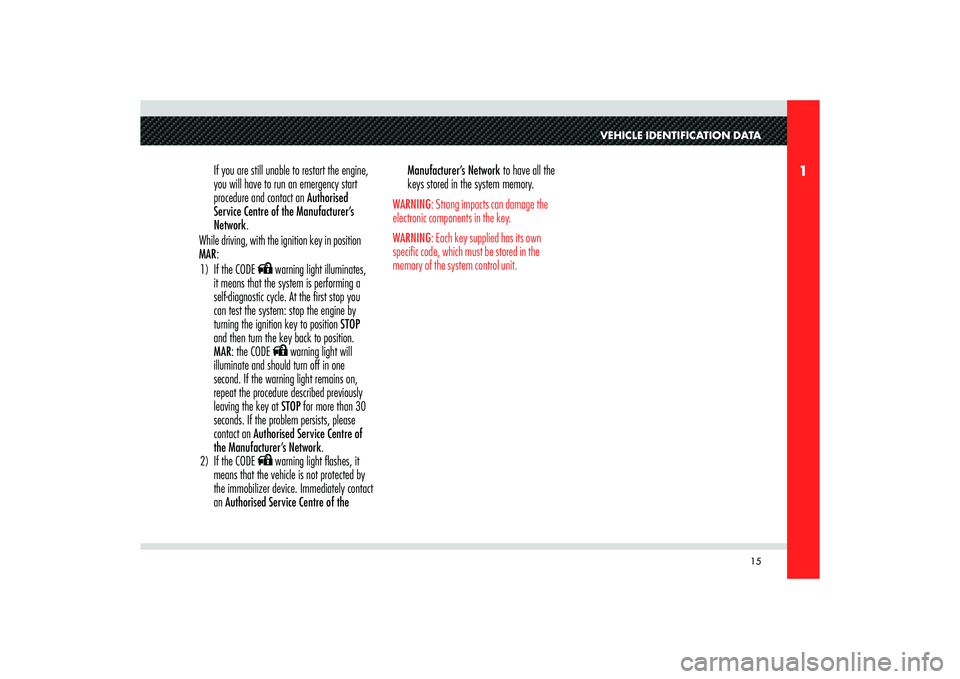
15
1
VEHICLE IDENTIFICATION DATA
If you are still unable to restart the engine,
you will have to run an emergency start
procedure and contact an Authorised
Service Centre of the Manufacturer’s
Network.
While driving, with the ignition key in position
MAR:
1) If the CODE
warning light illuminates,
it means that the system is performing a
self-diagnostic cycle. At the fi rst stop you
can test the system: stop the engine by
turning the ignition key to position STOP
and then turn the key back to position.
MAR: the CODE warning light will
illuminate and should turn off in one
second. If the warning light remains on,
repeat the procedure described previously
leaving the key at STOP for more than 30
seconds. If the problem persists, please
contact an Authorised Service Centre of
the Manufacturer’s Network.
2) If the CODE warning light fl ashes, it
means that the vehicle is not protected by
the immobilizer device. Immediately contact
an Authorised Service Centre of the Manufacturer’s Network to have all the
keys stored in the system memory.
WARNING: Strong impacts can damage the
electronic components in the key.
WARNING: Each key supplied has its own
specifi c code, which must be stored in the
memory of the system control unit.
Page 18 of 223
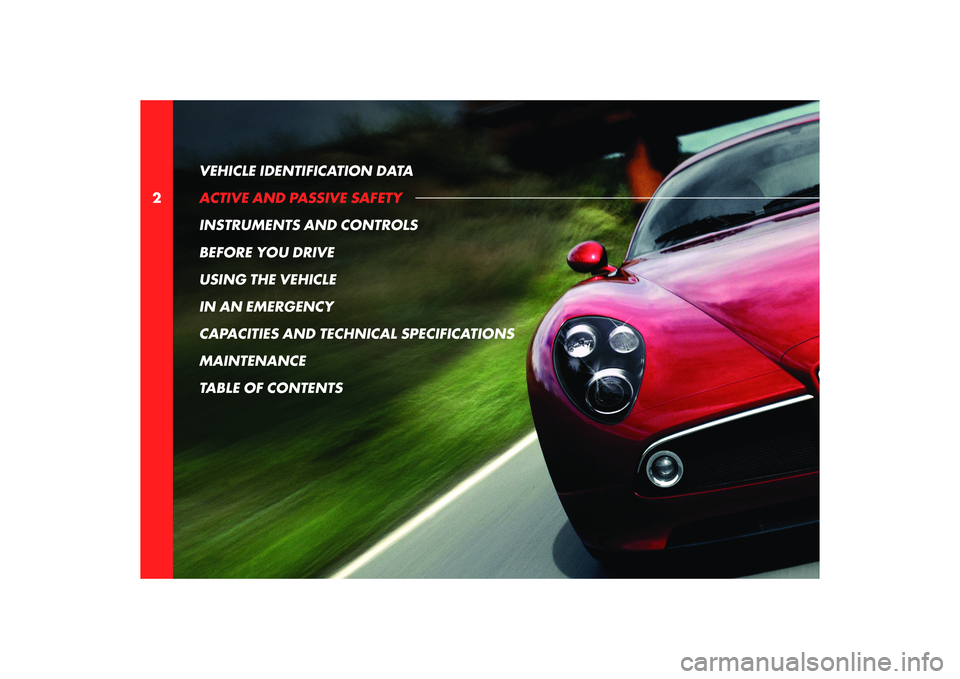
2VEHICLE IDENTIFICATION DATA
ACTIVE AND PASSIVE SAFETY
INSTRUMENTS AND CONTROLS
BEFORE YOU DRIVE
USING THE VEHICLE
IN AN EMERGENCY
CAPACITIES AND TECHNICAL SPECIFICATIONS
MAINTENANCE
TABLE OF CONTENTS
Page 19 of 223
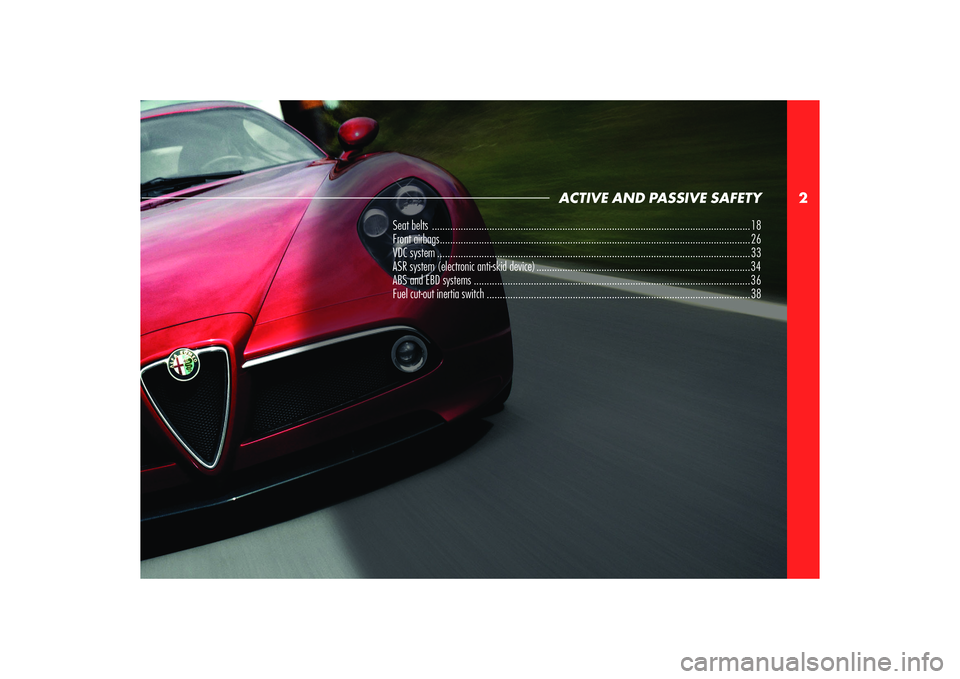
2
ACTIVE AND PASSIVE SAFETY
Seat belts .......................................................................................................................... 18
Front airbags ....................................................................................................................... 26
VDC system ........................................................................................................................ 33
ASR system (electronic anti-skid device) .................................................................................. 34
ABS and EBD systems .......................................................................................................... 36
Fuel cut-out inertia switch ..................................................................................................... 38
Page 20 of 223
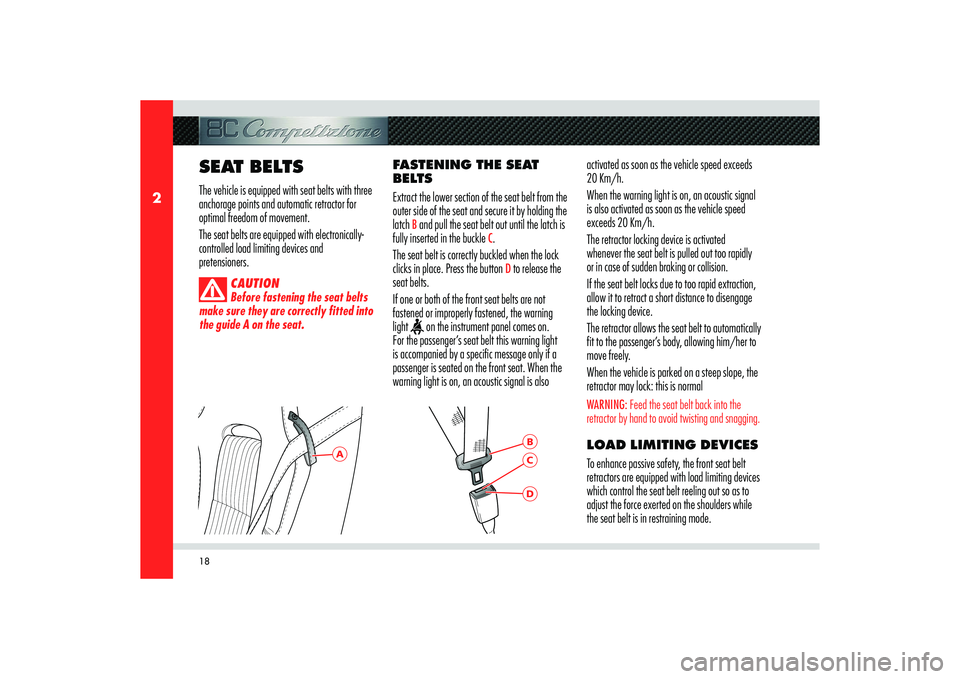
18
2
A
BDC
SEAT BELTS The vehicle is equipped with seat belts with three
anchorage points and automatic retractor for
optimal freedom of movement.
The seat belts are equipped with electronically-
controlled load limiting devices and
pretensioners.
CAUTION
Before fastening the seat belts
make sure they are correctly fitted into
the guide A on the seat.
FASTENING THE SEAT
BELTS
Extract the lower section of the seat belt from the
outer side of the seat and secure it by holding the
latch
B and pull the seat belt out until the latch is
fully inserted in the buckle
C.
The seat belt is correctly buckled when the lock
clicks in place. Press the button
D to release the
seat belts.
If one or both of the front seat belts are not
fastened or improperly fastened, the warning
light
on the instrument panel comes on.
For the passenger’s seat belt this warning light
is accompanied by a specific message only if a
passenger is seated on the front seat. When the
warning light is on, an acoustic signal is also activated as soon as the vehicle speed exceeds
20 Km/h.
When the warning light is on, an acoustic signal
is also activated as soon as the vehicle speed
exceeds 20 Km/h.
The retractor locking device is activated
whenever the seat belt is pulled out too rapidly
or in case of sudden braking or collision.
If the seat belt locks due to too rapid extraction,
allow it to retract a short distance to disengage
the locking device.
The retractor allows the seat belt to automatically
fit to the passenger’s body, allowing him/her to
move freely.
When the vehicle is parked on a steep slope, the
retractor may lock: this is normal
WARNING: Feed the seat belt back into the
retractor by hand to avoid twisting and snagging.LOAD LIMITING DEVICES
To enhance passive safety, the front seat belt
retractors are equipped with load limiting devices
which control the seat belt reeling out so as to
adjust the force exerted on the shoulders while
the seat belt is in restraining mode.